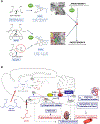New Approaches Targeting the Renin-Angiotensin System: Inhibition of Brain Aminopeptidase A, ACE2 Ubiquitination, and Angiotensinogen
- PMID: 37348757
- PMCID: PMC10730775
- DOI: 10.1016/j.cjca.2023.06.013
New Approaches Targeting the Renin-Angiotensin System: Inhibition of Brain Aminopeptidase A, ACE2 Ubiquitination, and Angiotensinogen
Abstract
Despite the availability of various therapeutic classes of antihypertensive drugs, hypertension remains poorly controlled, in part because of poor adherence. Hence, there is a need for the development of antihypertensive drugs acting on new targets to improve control of blood pressure. This review discusses novel insights (including the data of recent clinical trials) with regard to interference with the renin-angiotensin system, focusing on the enzymes aminopeptidase A and angiotensin-converting enzyme 2 (ACE2) in the brain, as well as the substrate of renin- angiotensinogen-in the liver. It raises the possibility that centrally acting amino peptidase A inhibitors (eg, firibastat), preventing the conversion of angiotensin II to angiotensin III in the brain, might be particularly useful in African Americans and patients with obesity. Firibastat additionally upregulates brain ACE2, allowing the conversion of angiotensin II to its protective metabolite angiotensin-(1-7). Furthermore, antisense oligonucleotides or small interfering ribonucleic acids suppress hepatic angiotensinogen for weeks to months after 1 injection and thus could potentially overcome adherence issues. Finally, interference with ACE2 ubiquitination is emerging as a future option for the treatment of neurogenic hypertension, given that ubiquitination resistance might upregulate ACE2 activity.
Copyright © 2023 The Authors. Published by Elsevier Inc. All rights reserved.
Figures




Similar articles
-
Brain ACE2 activation following brain aminopeptidase A blockade by firibastat in salt-dependent hypertension.Clin Sci (Lond). 2021 Mar 26;135(6):775-791. doi: 10.1042/CS20201385. Clin Sci (Lond). 2021. PMID: 33683322
-
Targeting Brain Aminopeptidase A: A New Strategy for the Treatment of Hypertension and Heart Failure.Can J Cardiol. 2020 May;36(5):721-731. doi: 10.1016/j.cjca.2020.03.005. Epub 2020 Mar 6. Can J Cardiol. 2020. PMID: 32389345 Review.
-
Firibastat: a Novel Treatment for Hypertension.Curr Hypertens Rep. 2021 Dec 24;23(12):46. doi: 10.1007/s11906-021-01163-4. Curr Hypertens Rep. 2021. PMID: 34950965 Review.
-
Fifty years of research on the brain renin-angiotensin system: what have we learned?Clin Sci (Lond). 2021 Jul 30;135(14):1727-1731. doi: 10.1042/CS20210579. Clin Sci (Lond). 2021. PMID: 34291792 Review.
-
Central antihypertensive effects of orally active aminopeptidase A inhibitors in spontaneously hypertensive rats.Hypertension. 2012 Aug;60(2):411-8. doi: 10.1161/HYPERTENSIONAHA.112.190942. Epub 2012 Jun 18. Hypertension. 2012. PMID: 22710644
Cited by
-
Janus Kinase 2/Signal Transducer and Activator of Transcription 3/Cyclooxygenase 2 Signaling Pathway Mediates the Effect of Central Angiotensin II on the Elevation of Rostral Ventrolateral Medulla Prostaglandin E2-Induced Oxidative Stress in Hypertension.J Am Heart Assoc. 2025 Jan 21;14(2):e036762. doi: 10.1161/JAHA.124.036762. Epub 2025 Jan 16. J Am Heart Assoc. 2025. PMID: 39817553 Free PMC article.
-
UBR1 Promotes Sex-Dependent ACE2 Ubiquitination in Hypertension.Hypertension. 2025 Jan;82(1):84-95. doi: 10.1161/HYPERTENSIONAHA.124.23196. Epub 2024 Nov 27. Hypertension. 2025. PMID: 39601126
-
Ubiquitination of angiotensin-converting enzyme 2 contributes to the development of pulmonary arterial hypertension mediated by neural precursor cell-expressed developmentally down-regulated gene 4-Like.Respir Res. 2024 Aug 29;25(1):326. doi: 10.1186/s12931-024-02953-5. Respir Res. 2024. PMID: 39210401 Free PMC article.
-
Angiotensin-Converting Enzyme 2 Posttranslational Modifications and Implications for Hypertension and SARS-CoV-2: 2023 Lewis K. Dahl Memorial Lecture.Hypertension. 2024 Jul;81(7):1438-1449. doi: 10.1161/HYPERTENSIONAHA.124.22067. Epub 2024 Apr 3. Hypertension. 2024. PMID: 38567498 Free PMC article. Review.
-
Physiopathology of the Brain Renin-Angiotensin System.Life (Basel). 2025 Aug 21;15(8):1333. doi: 10.3390/life15081333. Life (Basel). 2025. PMID: 40868980 Free PMC article. Review.
References
-
- Global, regional, and national comparative risk assessment of 84 behavioural, environmental and occupational, and metabolic risks or clusters of risks for 195 countries and territories, 1990–2017: a systematic analysis for the Global Burden of Disease Study 2017. Lancet. 2018;392:1923–1994. - PMC - PubMed
-
- Kearney PM, Whelton M, Reynolds K, Muntner P, Whelton PK, He J. Global burden of hypertension: analysis of worldwide data. Lancet. 2005;365:217–223. - PubMed
-
- Benjamin EJ, Virani SS, Callaway CW, et al. Heart Disease and Stroke Statistics-2018 Update: A Report From the American Heart Association. Circulation. 2018;137:e67–e492. - PubMed
-
- Hales CM, Carroll MD, Fryar CD, Ogden CL. Prevalence of Obesity and Severe Obesity Among Adults: United States, 2017–2018. NCHS Data Brief. 2020:1–8. - PubMed
Publication types
MeSH terms
Substances
Grants and funding
LinkOut - more resources
Full Text Sources
Medical

